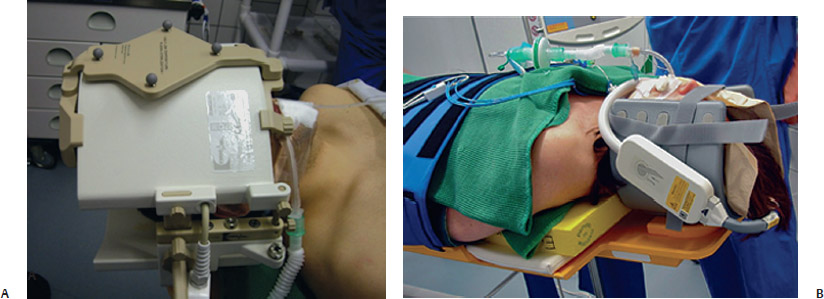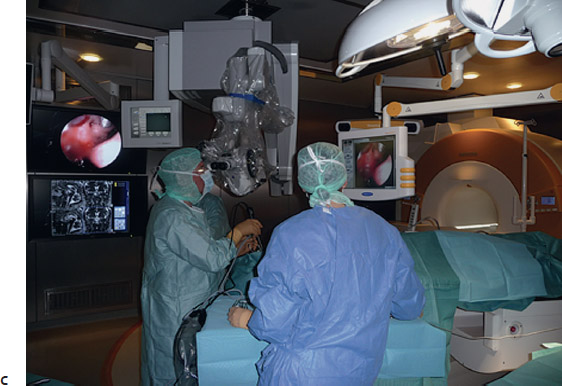27 The Utility of Intraoperative MRI in Pituitary Surgery
Summarizing the past one and half decades of intraoperative magnetic resonance imaging (IMRI), its utility has been documented mainly in the treatment of pituitary adenomas, although benefit has also been shown in other parasellar tumors such as craniopharyngiomas. For adenomas, 30 to 40% of totally resectable tumors achieve total removal, which could not be obtained at the primary procedure without IMRI.
In addition to other advanced technologies that have been introduced into the operating room in recent years for transsphenoidal surgery such as neuronavigation1–5 and endoscopy,6–8 IMRI5,9–14 is used as an immediate intraoperative quality control, evaluating the extent of tumor removal during the surgical procedure, which allows us to extend resections in those cases where tumor remnants are documented.9–14
In one third of macroadenomas, both low-field and especially high-field 1.5-tesla (T) IMRI scanners are able to document adenoma remnants as small as 3 to 4 mm for high-field scanners; these remnants were hidden to the surgeon’s eye in folds of the descending diaphragm sella.
The development of IMRI imaging started in the mid-1990s. The application was pioneered by Black et al,6 who operated in continuously running magnetic field using the so-called double-doughnut system, whereas the 0.2-T open MRI installations in Erlangen and Heidelberg represented the concept of transporting the patient into the magnet while performing surgery outside the strong magnetic field. The evolution from low-field to high-field MR scanners led to a renaissance of the idea of intraoperative imaging in trans-sphenoidal surgery for resection control and high-quality intraoperative images. High-field MRI has a clear advantage in image resolution compared with the intraoperative low- and mid-field MR system (0.12–0.5T).16,17
Not only patients with large tumors but also those with smaller adenomas, especially those extending against and into the cavernous sinus, can profit from IMRI control.
Not only hormonally inactive but also larger hormonally active tumors, in acromegaly and Cushing’s disease, profit from IMRI, by an increased rate of complete tumor removal as well as a higher role of endocrine normalization and “near normalization.”18 In nonfunctioning tumors, there are no hormonal markers available that would enable an early prognosis of outcome.
Because in the great majority of cases the excellent IMRI resolution of images (mainly obtained by 1.5 T) permits comprehensive evaluation of the relevant anatomy, the conventional postoperative MRI scan performed 2 to 3 months after surgery (without artifact) can be avoided.
 Operating Room Setup
Operating Room Setup
Today several different industrial companies offer low-field (0.15 T, Medtronic, Minneapolis, MN; 0.2 T, Siemens AG Medical Solutions, Hannover, Germany), mid-field (0.3 T, Hitachi; 0.5 T, General Electric, Hannover, Germany), high-field (1.5 T, General Electric, Philips [Andover, MA], Siemens), and ultra-high-field (3 T, General Electric, Philips, Siemens) scanners. The senior author started with a 0.2-T system (Magnetom Open, Siemens) in 1996, followed by a 1.5-T system (Sonata, Siemens) in 2002 in Erlangen.
We now present our current system, the “INI Brain Suite,” an operating theater with a 1.5-T Magnetom Espree scanner (Siemens), which was installed in 2006/2007 at the International Neuroscience Institute (INI) in Hannover, Germany. This is a high-field MRI scanner with a superconductive 1.5-T magnet with a length of 160 cm and an inner bore diameter of 70 cm equipped with a gradient system having a field strength of up to 40 mT/m (effective 69 mT/m) and an effective slew rate of up to 200 T/m/s effective. This was the first “open” 1.5-T MRI used for therapeutic purposes.
A rotatable surgical table (Trumpf, Saalfeld, Germany) is adapted to the scanner to allow for a special surgical MRI tabletop. This surgical table can be locked into various positions. The principal surgical position is at 160 degrees, with the patient’s head at the 5-gauss (G) line (distance of 4 m to the center of the scanner). As soon as the rotating mechanism has been locked, the height of the table, the angle of tilt, and the lateral tilt can be modified. The table movements are controlled remotely. Only the rotation about the table axis to turn the table into the axis of the scanner is performed manually, for safety reasons.
MRI-compatible ventilation (Aestiva 5/MRI, General Electric) and MRI-compatible monitoring are available for control of anesthesia and for wireless 2.4-GHz data transfer from the radiofrequency-shielded cabin. The perfusions and infusion pumps are shielded for MRI compatibility.
Our endoscopic equipment includes a 0- and 30-degree, 4-mm rigid endoscope Hopkins II (Karl Storz, Tuttlingen, Germany), a full high-definition (HD) camera IMAGE1 H3-Z, and a wide-view HD screen. The use of the endoscope in our “BrainSuite” operating room, with 1.5-T MRI, performing surgery at the 5-G line, is similar to its use in a normal routinely operating theater without IMRI.
In the majority of cases, microscopic tumor removal is performed with the ceiling-mounted Pentero C Multivision microscope (Zeiss, Oberkochen, Germany). The holding device is placed in the middle line within the 5-G line; the microscope itself can have a flexible position in connection with the preferred position of the operating field (as far as we know, we were the first to test this MRI-compatible ceiling-mounted Zeiss Pentero system).
Navigation is indicated in tumors with either encased arteries or loss of anatomical landmarks as occurs in reoperations. We use the BrainLab integrated VectorVision Sky Navigation System (BrianLab, Heimstetten, Germany) with a ceiling-mounted infrared camera and touch-screen display. The patient is placed in a special ceramic head-holding system (Fig. 27.1A), and the registration is done automatically through an integrated special coil system. A fiberoptic con-nection ensures MR-compatible integration into the radio-frequency room. The camera used to monitor the position of the microscope and other instruments is also ceiling-mounted, as well as the touch screen, which is used to operate the navigation system. Two 50-inch flat-screen monitors mounted on the left wall of the BrainSuite are available for viewing the images from the microscope and the MR console, as well as various software applications.
The microscope and endoscope video is recorded using Medimage software (Vepro, Pfungstadt, Germany) in parallel in the MR control room. The instrument table and the various rotating stools (Trumpf, Ditzingen, Germany) are fully MR compatible.
The procedures for emergency magnet quenching and for monitoring of oxygen levels in the operating room are the same as those in standard clinical MRI installations.
 Transsphenoidal Surgery and Intraoperative MRI
Transsphenoidal Surgery and Intraoperative MRI
In our current series of pituitary adenomas, 95% of tumors are approached via the direct endonasal transsphenoidal approach. Head fixation is not required, and imaging is performed using a standard U-shaped large flexible coil that is adapted and draped to the head (Fig. 27.1B).
The surgeon, using Cushing’s positioning for transsphenoidal surgery, is standing behind the patient’s head (Fig. 27.1C). A schematic outline of the operating room was published previously.11,19
The whole transsphenoidal procedure is identical to that performed in regular operating rooms. The sublabial and unilateral paraseptal approaches to the sphenoidal sinus are used less frequently. We generally prefer the direct endonasal transsphenoidal approach with endoscope assistance. The entrance into the sphenoid sinus is guided by endoscopic visualization, as well as identification of the sellar floor and the carotid arteries. Furthermore, the endoscope is very helpful during resection of tumor remnants in the cavernous sinus and in folds of the descending diaphragm, supplementing microsurgical tumor removal.


Fig. 27.1 (A) A rigid navigated magnetic resonance (MR) coil is used to hold the head in a fixed position during the surgical procedure. (B) A flexible MR coil is placed around the head, so that the head can be moved during surgery without restrictions; a coil-preamplifier is at-tached to the flexible coil by a tape. (C) The intraoperative scenario in our MR operating room for microneurosurgical procedures. The head is placed at the 5-G red line; the surgeon is standing behind the head (Cushing’s position). The micro scope and its associated monitor are secured to the ceiling of the operating room, on the left side of the surgeon and the instrument tables, with the endoscope and the nurses stationed on the right side of the surgeon. The anesthesiologist’s workstation is located in the right corner of the operating room, opposite the end of the MRI table. The circuit for the endotracheal tube is connected to an MRI-compatible anesthesia machine. Many standard surgical instruments can be used between the 5- and 20-G magnetic field lines. Two 50-inch plasma monitors are located on the left wall of the operating room. A movable MRI-compatible navigation monitor and infrared navigation arm are located close to the left middle part of right wall. An extra 21-inch LCD monitor is attached to the ceiling on the left side of the operating room.
Less frequently, we have performed a purely endoscopic resection of an adenoma, although purely endoscopic surgery is frequently used during the removal of other parasellar tumors such as chordomas centered in the clivus.
Porcelain-coated drills are used, especially to avoid metal artifacts during imaging, to open the sphenoid sinus and to remove the sellar floor. Transsphenoidal surgery is routinely accompanied by endonasal endoscopic inspection using 0- and 30-degree, 4-mm rigid endoscopes to visualize the surgical site, which is projected on a ceiling-mounted monitor or through the eyepiece of the microscope. Selective adenomectomy is achieved in all patients. In general, regular operating microinstruments are used during the transsphenoidal surgery at the 5-G line. In contrast to earlier years when we used an MRI-compatible nasal speculum for intraoperative imaging, the direct endoscopic-assisted endonasal approach permits us to examine the sella without the speculum, by installing a simple piece of cotton as a placeholder in the nasal cavity. If necessary, especially in cases with defects of the diaphragm sella and cerebrospinal fluid (CSF) leaks, the sellar floor was covered at the end of surgery with fascia or subcutaneous fat tissue, which was obtained during the same surgical session from the right thigh positioned within the 5-G perimeter. For safety reasons, we used fully MRI-compatible instruments to obtain the fascia. In the case of intraoperative CSF leakage, temporary lumbar drainage is utilized. In direct endonasal surgery, no nasal packing is necessary.
The timing of intraoperative imaging is decided by the neurosurgeon; intraoperative imaging is performed either when the neurosurgeon has the impression that a complete tumor removal was done or, in the case of incomplete tumor removal, when he thinks no further removal at this stage of surgery is possible using the transsphenoidal approach. Just before intraoperative imaging, the opened sellar floor is covered with a flat piece of bone wax for better delineation of the sella outlines in the intraoperative images, minimizing artifacts caused by blood from the sphenoid sinus or the nasal cavity. Then the surgical site is covered with a sterile drape, and the MRI table is rotated 160 degrees into the scanner. The time between the decision for intraoperative MRI and the actual start of imaging is approximately 2 minutes.
After the patient is moved into the center of the scanner, certain circuits are switched off, including the fluorescent lamps and the operating microscope. The imaging starts with a localizer sequence (field of view [FOV], 280 mm; repeat time [TR], 20 milliseconds; echo time [TE], 50 milliseconds; scan time, 9 seconds). A T2-weighted, half-Fourier, single-shot turbo spin echo sequence (slice thickness, 5 mm; FOV, 230 mm; TR, 1000 milliseconds; TE, 89 milliseconds; scan time, 25 second at five acquisitions) is performed in coronal and sagittal orientation to give a quick overview of the operative site. Afterward, T1-weighted coronal and sagittal spin echo sequences are acquired (slice thickness, 3 mm; FOV, 270 mm; TR, 450 milliseconds; TE, 12 milliseconds; scan time, 4 minutes 57 seconds at four acquisitions). In addition, high-resolution T2-weighted turbo spin echo sequences with an in-plane resolution of 0.6 × 0.4 mm are obtained (slice thickness, 3 mm; FOV, 230 mm; TR, 4000 milliseconds; TE, 97 milliseconds; scan time, 6 minutes 6 seconds at three acquisitions).
Stay updated, free articles. Join our Telegram channel

Full access? Get Clinical Tree


